Update: now with click-able big-able pictures!
I’ve been cogitating a lot about fat bikes these last few months.
You might have spotted these larger than life, balloon-tyre bikes out and about – they’re all the rage right now, as riders branch away from using them specifically for Alaskan snow duties or desert crawling, to less weather-specific trail escapades.
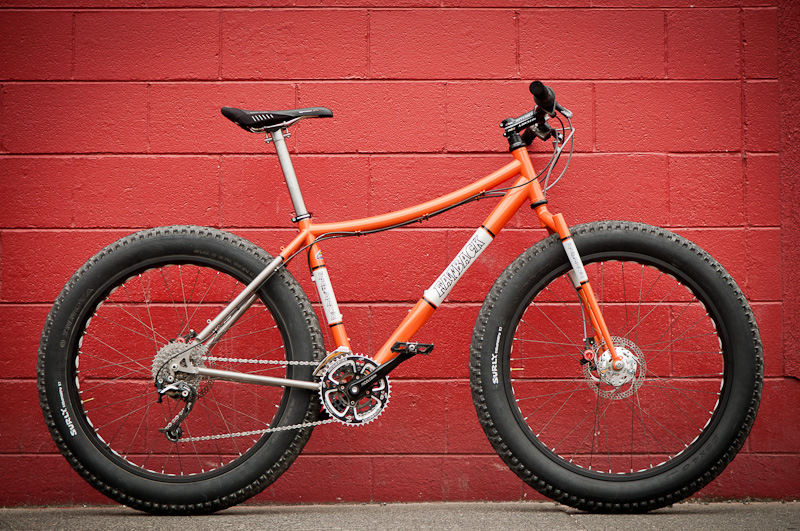
A titanium Fatback fatbike, photographed at the beginning of my trans-american journey, up in Alaska in 2009. Tyres are typically over 3.8in wide, and can be run at absurdly low air pressures – down to 5psi – for crawling through snow and sand. More basic models weigh in at around the 35lb+ mark. I seem to remember this one was sub 28.
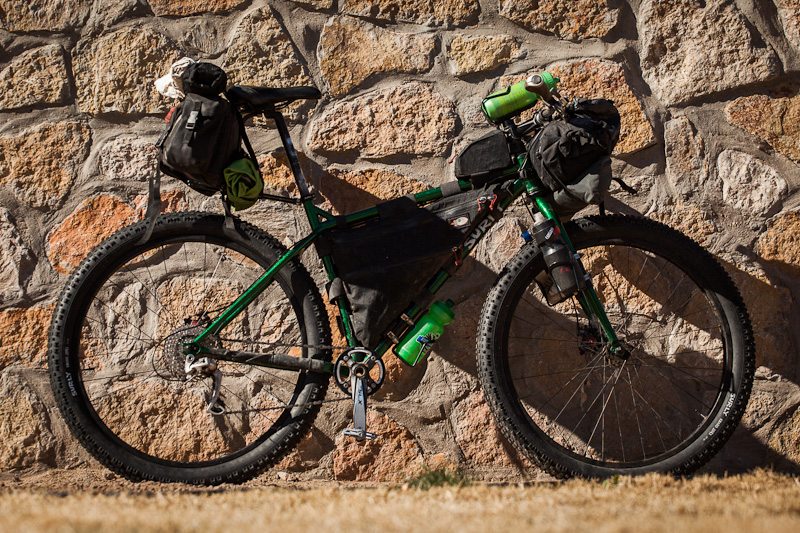
The 29+ Surly Krampus, with its 29×3 Knards. Not as much float as a fat bike, but more lively on trails. The tyre diameter is actually a little larger than that of a 26×3.8 tyre.
Recently, I’ve notched up a fair few miles on the semi-fat Krampus, and although I’ve never spent much time on a ‘true’ fat bike, I’m beginning to really see their potential. That’s not to say that extra wide, low pressure tyres are a requirement for backcountry adventures; more that something about them prods you into doing trips a little out of the ordinary.
Before I was fortunate enough to get my hands on the latest Surly, I was on the verge of biting the bullet on one for the winter (and more) – inspired first by Jakub’s Stock Canning adventure, then by Joe’s travels through Latin America and Nick’s unorthodox journey down from Alaska, and now Dirt Dot Kurt. Further internet dabblings at FatBike.com, Big Dummy Daddy, the Lazy Rando and Coast Kid served only to seal the deal, as did campfire discussions with Nick and Joe. (The general media have even latched on now – like NPR.) Anyway, I was all set to delve into the weird and wonderful world of offset frames, downhill bottom brackets and mammoth tyres – until the Krampus came along.
(Update: More fat bike travel inspiration from Kurt)
29+ v Full Fat
The way I see it, the Krampus is a beefcake 29er, a bruiser of a bike, boasting bags of extra cush and extra grip. It’s a whole lot of fun to ride. Those 3in Knards are a definite advantage through rock gardens and they’re noticeably more confidence-inspiring through mild snow too. Certainly, it beats me up a whole lot less than my go-to rigid forked Ogre. But as much as I love riding it, I don’t see the Krampus as an attempt to match the roving omni terra abilities of a real fatbike. That’s the domain of a different beast altogether.
For now, I’m living vicariously through others. Jeremy just bought a Surly Neck Romancer (more clever witticisms from the Surly peeps) so I joined him in collecting it from one of my favourite bike shops in Albuquerque, Two Wheel Drive.
The Neck Romancer is a marriage of sorts between the venerable Pugsley (the frame that helped popularise the movement) and the big foot of the fat bike world, the Surly Moonlander – in that it uses a Pugsley frame with a super wide Moonlander fork.
As far as I can decipher, it’s one of the most appealing, affordable way of getting into touring-friendly fat bikes. This year’s build kit includes weight saving cut out rims, plus a versatile Mr Whirly OD crankset and reliable Avid BB7 brakes. The finish is super stealth black, right down to the understated logos and spokes. And – having enjoyed a brief spin on it, I have to say I was really surprised by how fun it rides, despite its obvious heft.
I’m not in the position right now to go custom due to financial constraints, so given my requirements, I’ve whittled down my virtual list to a Salsa Mukluk 2, a Surly Neck Romancer and a standard Pugsley – all of which are relatively easy to get hold of in the US. Importantly, all three have a generous allowance of eyelets and rack mounts for touring potential – ruling out On One’s new budget Fatty for me. I don’t have enough experience to form concrete judgements, but these are my musings so far:
Mukluk 2
The 170mm rear symetrical spacing on the Mukluk appeals, as it lends itself to a second set of strong but light 29er wheels. The new frames can even fit Rabbit Holes and Knards. The downside? This requires investment in another 170mm hub, which doesn’t come cheap.
The aluminium frame is a touch lighter, and would be protected from rust ingress during a Baja Peninsula exploration, or corrosive salt on winter roads. The Mukluk 2 gets the all important cut out Rolling Darryl rims, a fancy e*thirteen crankset, an11-36T 10 speed cassette and 120tpi (ie ‘lightweight’) Surly Nates. All very nice bits of kit. But parts that also nudge the cost up to $2450…
Surly Neck Romancer/Pugsley
The Neck appeals as I really like the way it rides. It’s understated, it’s chromo (which I still find myself drawn to – especially if it’s to be strapped to the roof of a Peruvian bus) and the built kit is particularly appealing – there’s nothing but the saddle I’d rush to change. An asymmetrical frame means no need for running spendy, awkward to source hubs – but makes building up a set of lighter 29er wheels more of a challenge. It comes with nice bits too, including the many talented Mr Whirly OD chainset, Avid BB7 brakes, cut out rims and Microshift thumbies – all for $1900.
Like the Mukluk, the Neck has 82mm Rolling Darryls, which is great for eeking out as much grip and float as possible from a 3.8in tyre. But it does mean it won’t play as nice with the likes of a Schwalbe Big Apple 26×2.35, which would lend it more versatility for long distance touring. For that, a standard Pugsley, which uses narrower, 65mm Marge Lites – and comes in a wonderfully blunt yellow finish – might be best. The Pugs will set you back just $1650 – which I think is incredible value given how niche fat bikes and their components currently are (a complete Ogre is $1500, by way of example).
Running costs
For long distance touring, there’s a couple of factors worth taking into consideration. Not only are fat bike tyres heavy and hard to source, but they cost upwards of $90 each. While they’re good for many a mile on snowy adventures, they’re bound to wear considerably quicker on pavement and trail. Perhaps prices will drop as they become more popular, with the likes of the budget On One Fattie joining the fray.
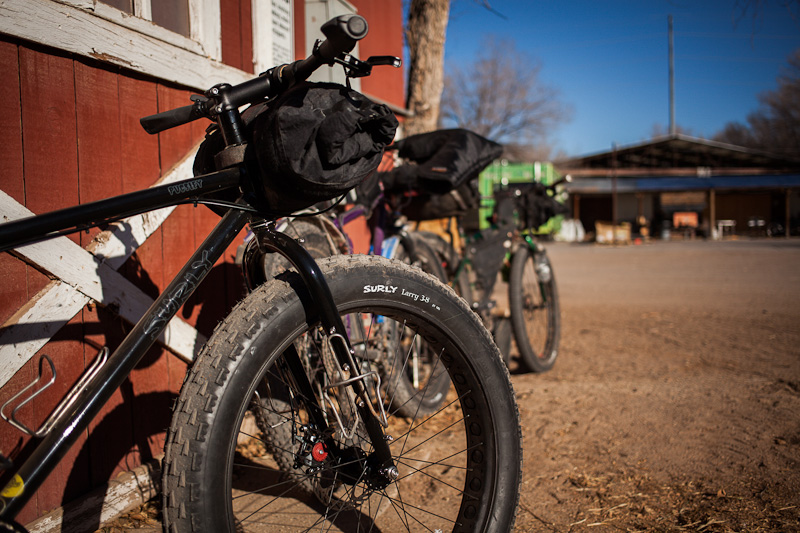
Fat bike fury: Jeremy’s ultra stealth Neck Romancer, Nick’s purple Pugs and my glittery green Krampus. The Neck comes well endowed with rack/mudguard/water bottle eyelets – though it would be nice to have seen a set under the downtube.
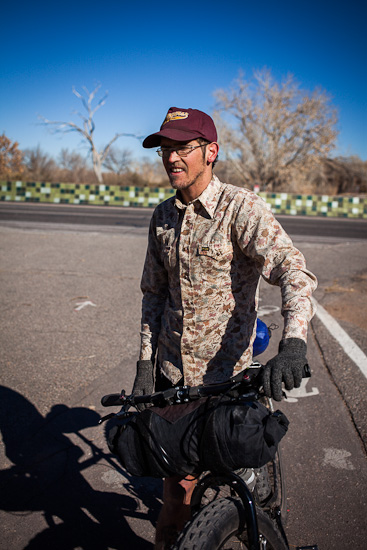
Jeremy and his new steed. Bike-friendly Albuquerque boasts a milder, even t-shirt friendly winter days, being almost 2000ft lower in elevation than nearby Santa Fe.
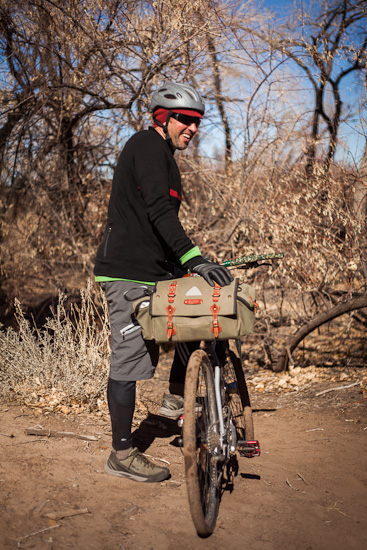
Local framebuilder Dave Salinas joined us for the day – seen here on a Skinny Bike. Dave lead us along the bosque singletrack that wends its way north though the cottonwoods to Bernalillo, some 25 miles away, where we connected with the Railrunner train to Santa Fe.
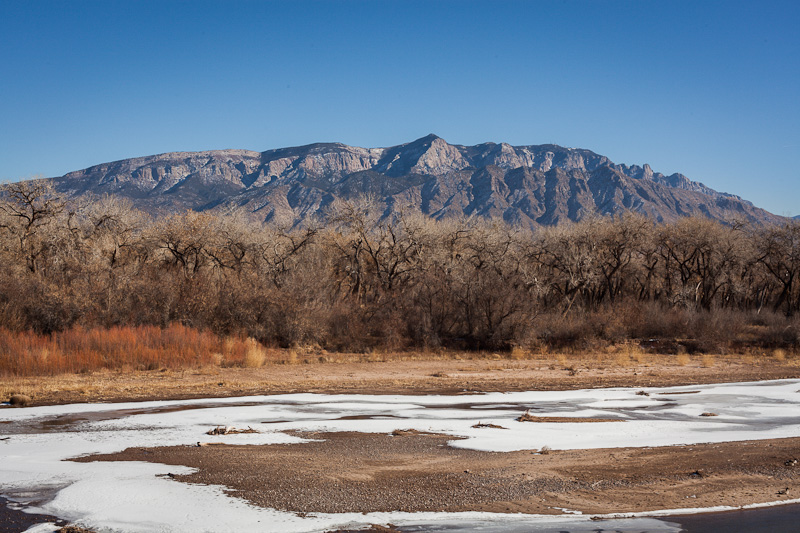
The Sandia Mountains. So named for their shape, and the colour they turn at sunset – like a slice of watermelon.
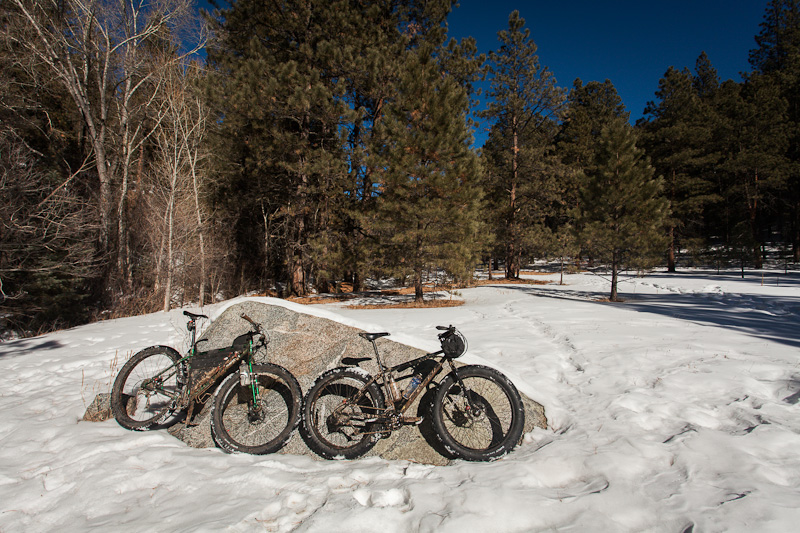
The next day, Jeremy and Iheaded into the Santa Fe National Forest to see how the Krampus and the Neck compared, riding Dale Ball, Chamisa and Windsor Trails.
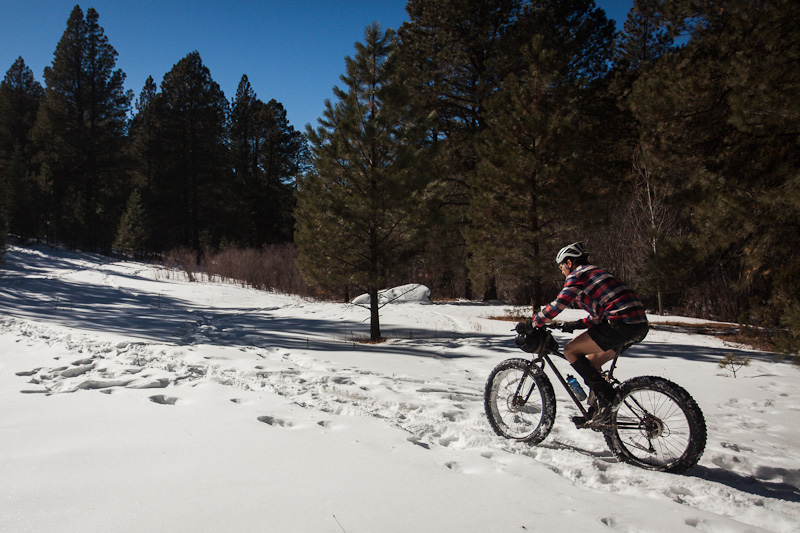
We considered heading north towards Borrego, but for the most part, the snow was too thick and powdery for even for fat tyres. So instead, we turned south and rode the Windsor Trail down to Tesuque.
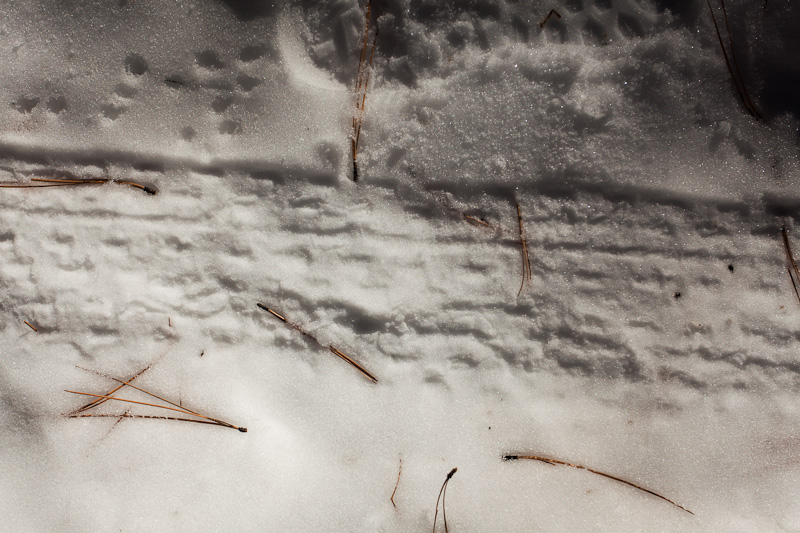
As luck would have it, we were following another set of fat tyre prints, that had done the hard work and packed down the trails nicely in front of us.
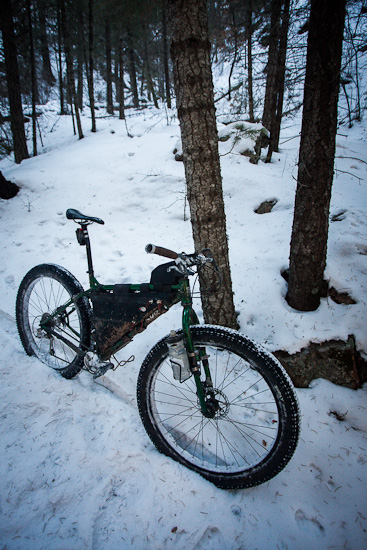
The Krampus struggled a bit where the snow was deeper; letting a whoosh of air from the front tyre made a considerable difference.
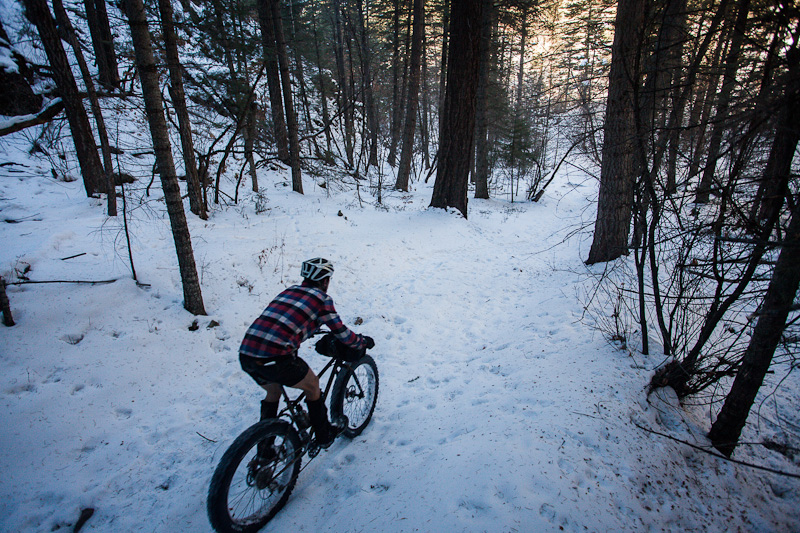
Then the trail became more and more rideable, treating us to big, powdery turns that we carved our way down. Fatbikes aren’t the panacea for any-terrain riding, but they certainly encourage you to make a good stab at it.
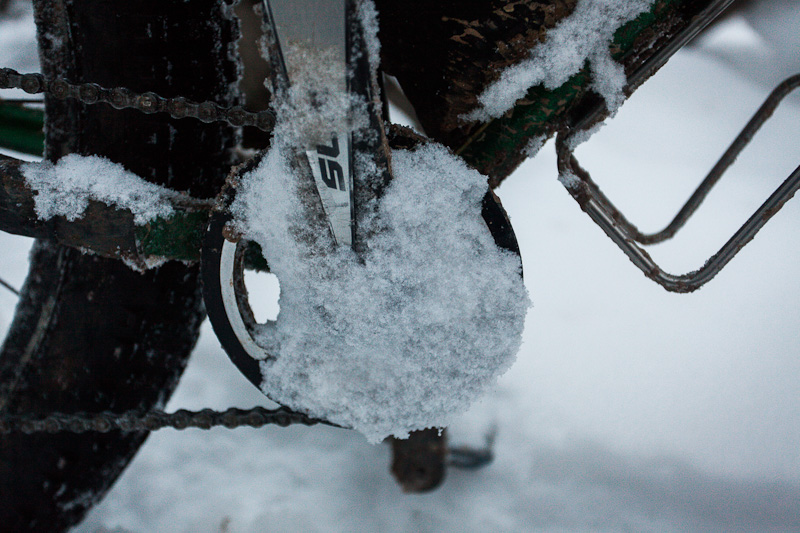
My plan is to rebuild my Rohloff for the Krampus, using one of Cycle Monkey’s nifty Monkey Bones. In the meantime, Nick had nudged the rear wheel a couple of millimetres to the non-drive side, to improve the chain line with a 1×9.
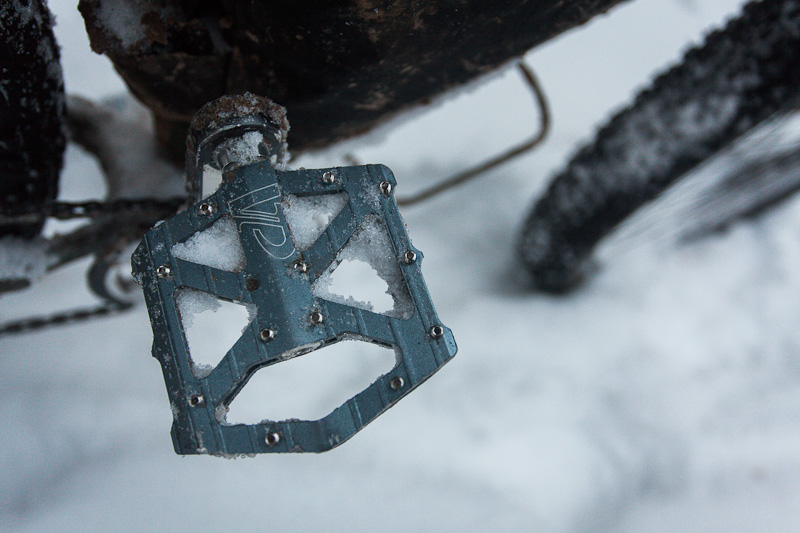
I’m still adjusting to the VP platform pedals for more technical mountain biking – but they’re definitely my pedal of choice for this kind of ride.
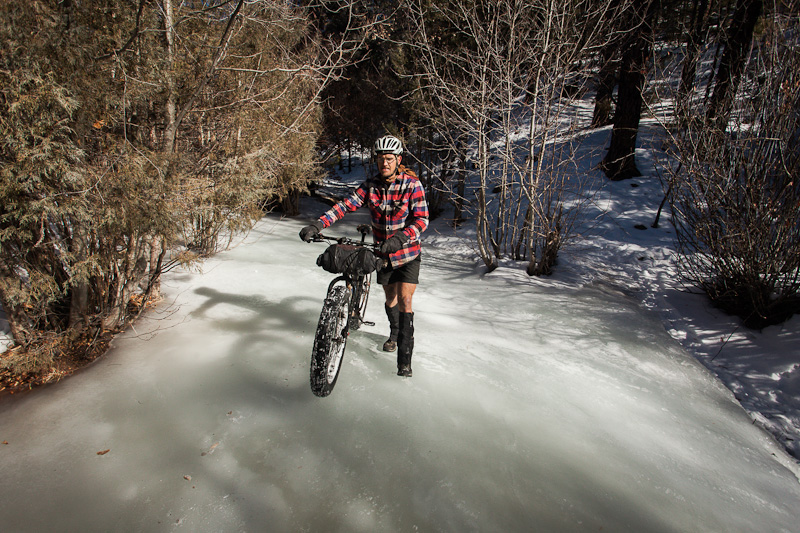
The descent included plenty of sketchy frozen river crossing, as we criss-crossed Tesuque Creek. If you stood still, you could hear the water babbling underneath.
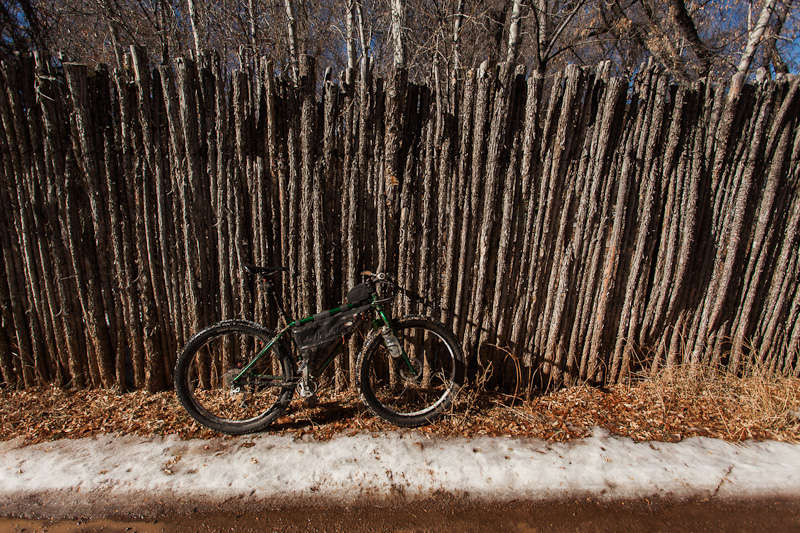
The Krampus, against my favourite coyote fence. There was an ebb and flow to the ride, with regards to the abilities of the Krampus and the Neck Romancer. Through thicker snow, the Neck felt advantageous, and where the trail improved, the Krampus took the lead.
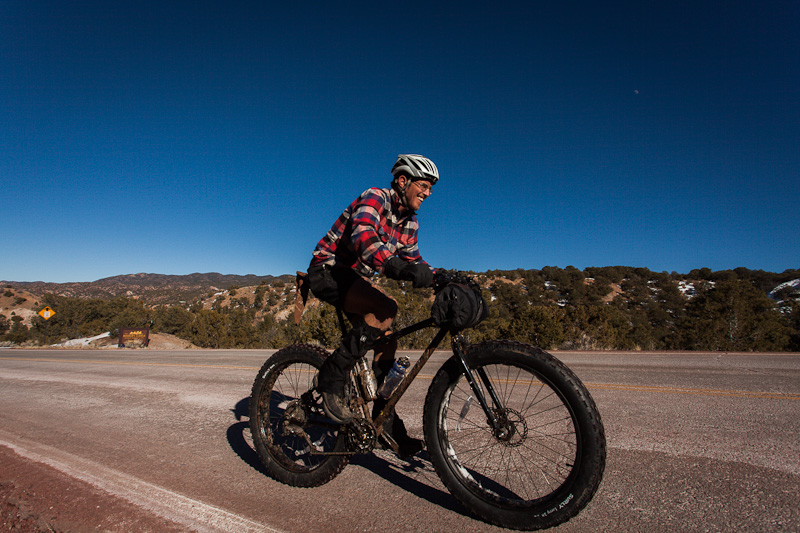
Heading back to Santa Fe. ‘How’s it roll on pavement?’ I asked Jeremy. ‘It’s altright. It’s still a fun bike!’ came the reply.
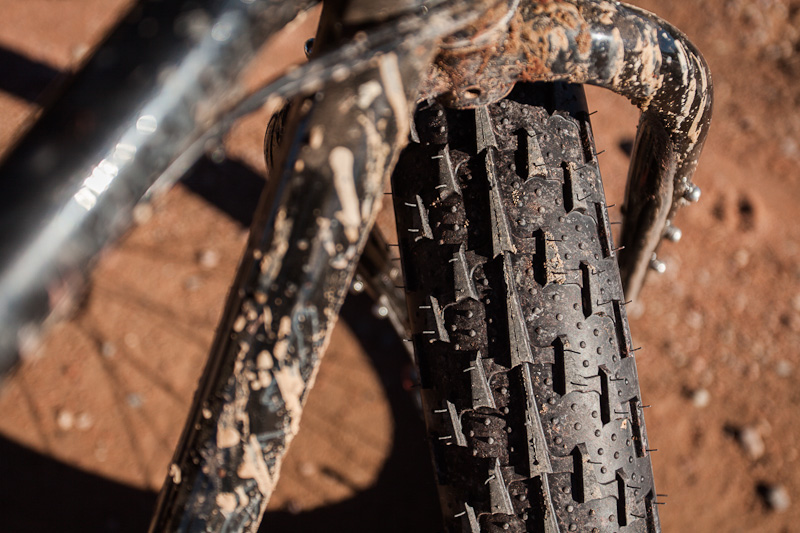
And now a muddy one too. Generous clearances on the symmetrical Moonlander fork, and water bottle or Anything Cage eyelets too. The Larry’s have central tread that seems to roll nicely.
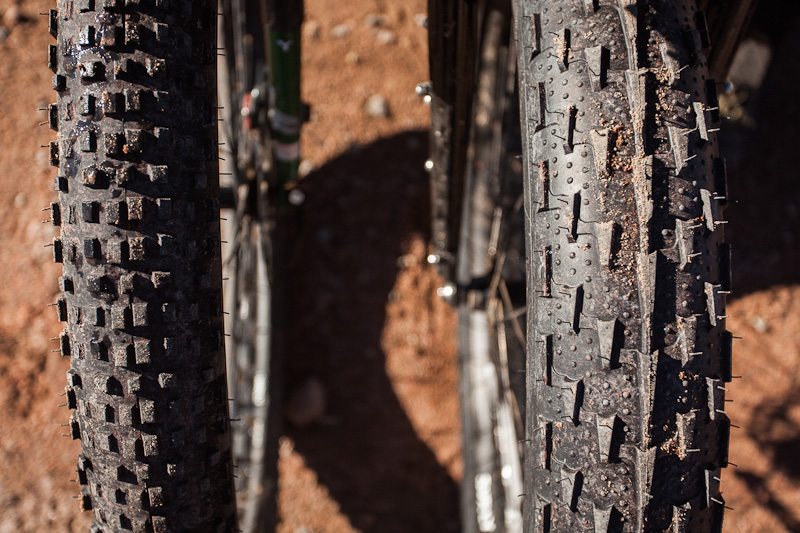
Knard 29×3 versus Larry 26×3.8. The rim difference is important too, with a Rabbit Hole measuring 50mm across and a Rolling Darryl 82mm.
Camera: Canon 5d Mk2, with 17-40mm f/4 lens.
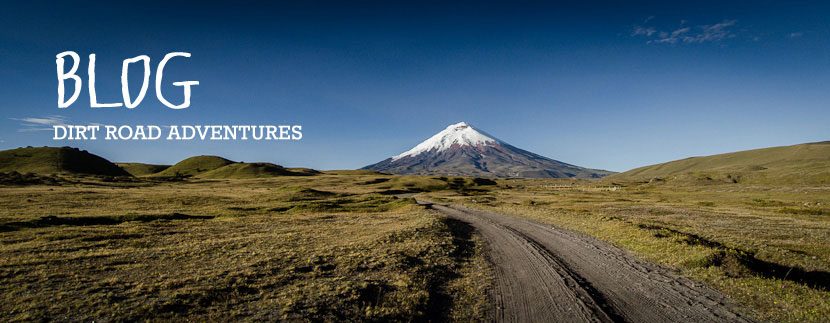
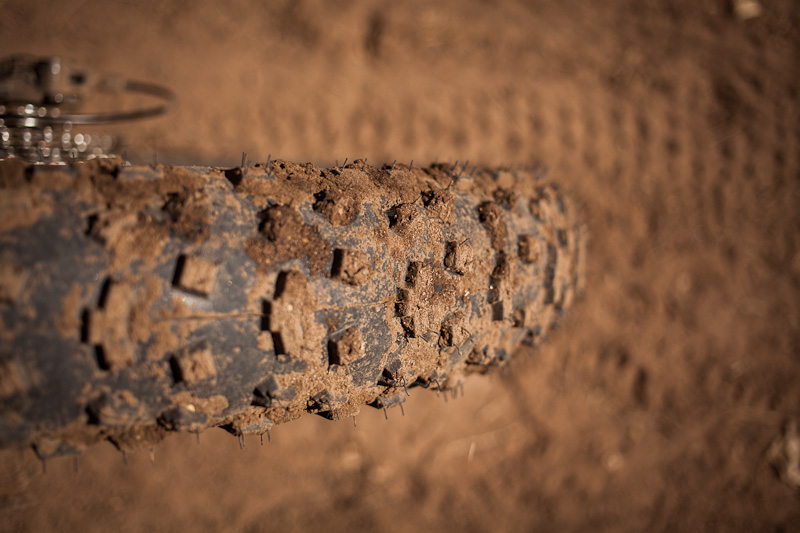
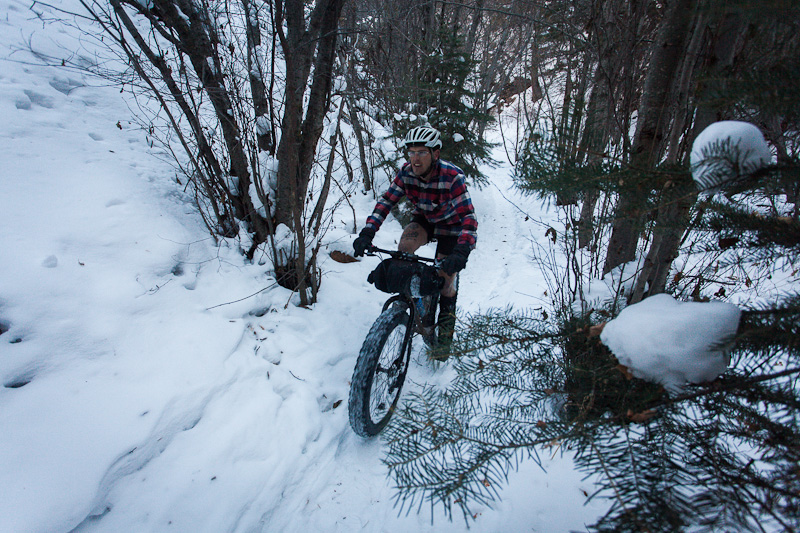
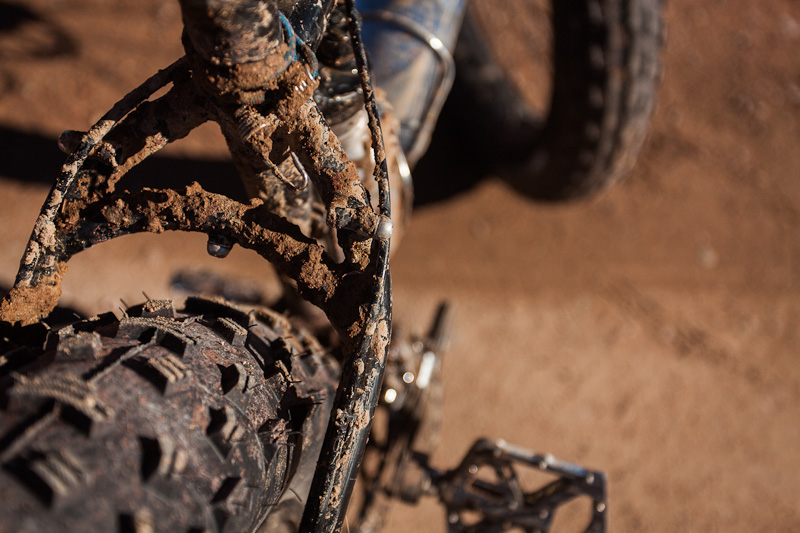
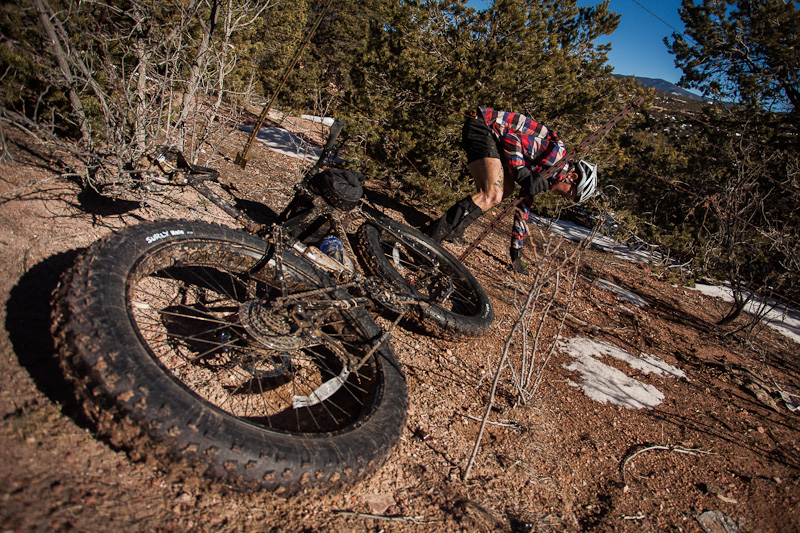
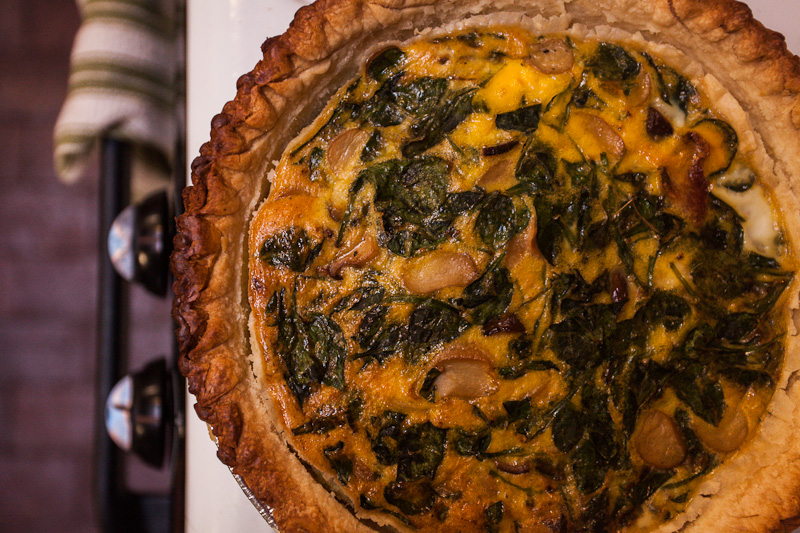

Looks like a fun ride. The thing that would allow more winter singletrack riding, evn more than bigger or better equipment, is broader participation. Fatbikes groom their own trails through use, so more riders equals better winter trails. Still, climbing on snow can be a challenge.
Btw, the Rolling Darryls are 82mm wide while the Clownshoe rims on the stock Moonlander are 100. Imagine that the Darryl spreads a 3.7/8″ tire the same way the Clownshoe fits a 4.7/8″. And, the Origin-8 fat tire is available for $44 MSRP (http://www.bikeman.com/JB-59469.html). Its heavy, but would be a good solution for applications that wear the tire quickly.
Funnily enough, I was thinking the same thing yesterday. If just a small group of fat bike riders were out regularly riding the trails, there would be so much winter singletrack potential here.
Thanks for the corrections – duly updated.
With Surly Rabbit Hole rims you can now build up summer 29er wheels for a Pugs that can run the fat 3″ 29er+ Knard or “normal” 2.3-2.4″ 29er MTB rubber. No odd spoke tension and no need for special hubs. You also get to use the Surly Pugs swappable front to rear wheels if you use a SS/FG front hub as a back up against rear hub/derailleur issues.
Hey Vik, yes, they certainly open up new possibilities. At 700g, they’re not especially light, even if the weight is extremely reasonable for their width – mind you, I’ve been pleased with how they’ve stood up so far. I need to try them out with 2.4s (Ardents spring to mind). Now they’re set up tubeless, I’m less inclined to swap tyres round too much.
But for a really versatile, lightweight second set of wheels, I’d maybe opt for something a little narrower. I’m a big fan of Schwalbe Duremes, for instance, for both pavement and well packed dirt. They’re light and pack down small – making a good spare. However, I’m not sure they’d be wide enough for the Rabbit Holes (though I have yet to try).
For this reason, I’m considering building up my Rohloff with a 35mm rim rather than the Rabbit Holes for the Krampus, to get (most of) the best of both worlds. But this route wouldn’t be so Pugs-friendly.
I think the ability to swap out the front and rear hub is valid for some of the more extreme places in the world. In all my touring experience, I’ve never been in a situation where I’ve needed to do it. It’s nice for peace of mind though.
I’m kind of in two minds about offset triangles and forks. I see the benefits, but feel a high quality, sealed bearing 170mm hub may well be a better solution much of the time. I’m sure one day I’ll regret saying that…
+1 for Viks proposal. Complete Pugsley (1×10 or so) for the fun winter time, swap to Rohloff/Rabbit Hole wheels for the rest of the year. For some more speed put on some Big Apples or else. When the Krampus came out, this was exactly my plan .. but somehow I thought building 36 hole wheels would be a good idea. So no Rabbit Holes for me .. But maybe I’ll give those Kris Holm unicycle rims (http://www.krisholm.com/khu/en/rims) a try – though only 38 mm wide and 100 g heavier .. but 36 hole. Yeah!
Anyway, love it with the fat tires and until now I had no problems keeping up with normal touring MTB riders .. It could be lighter though the weight sometimes has it’s benefits as well. I also sacrificed the wheel swap option for a 100 mm fork an a generator hub with I think is way more useful! At the moment I wouldn’t change anything on my build but 32 hole for the existing 36 to play around a little with rims/tires in the future (http://outsomewhere.wordpress.com/2012/12/29/pug-and-troll/)
Maybe the Krampus is a very nice ride but the versatility is on the Pugs’ side.
Wide (but < 50 mm) and light 29" rims are hard to find .. I only know Syntace (W35 MX – sadly only as a complete wheels .. and no option to get the rims solo, even as a shop, tried that), the mentioned Kris Holm rims, or Velocity's P35 (very soft aluminum ..).
Maybe try to ride a fully fatbike on dirt/road for a longer period and see if you can live with the weight and it's related speed decrease – I mean fully pumped up those endomorphs roll pretty well and fast on tarmac but the weight will slow you down a little. On snow/sand it's a clear choice of course.
Well, I'd say if you want a one-setup-do-it-all touring bike, the Rohloff'ed Krampus would be the best as it's lighter and faster. If you want maximum flexibility, go for the Pugsley and build it as you need it.
170 mm symmetrical frames would require an adaptor for your Rohloff .. which would be stupid as it is by far the best system one could get – and you already own one.
New website is looking Great. Nice to see your pictures bigger. Keep up the good work.
Thanks Blair.
This isn’t the new site, but the pics will be the same size, and expand similarly too. I’ll attempt to trudge back through some of the older posts and resize…
Although I like virtually all of the fatbikes I’ve encountered for one reason or another, I chose my Neck Ro Pug for the reasons you outlined, this even before I had any awareness of the Krampus. I think it’s hard to go wrong with either a Neck or normal Pugsley for all its adaptability. That said, I briefly rode an early Mukluk and liked it, though aluminum is not really my thing.
I’m a little jealous of the 2013 Neck specs, as my 2012 has the less sexy unholy Rolling Darryls, but I’m not one to worry too much about a little extra weight. I agree that with an under the downtube bottle mount (or ideally and Anything cage mount) it would have the perfect complement of braze ons.
Good hunting.
Space and a few extra greens are the only things holding me back, believe you me.
Like you, I feel inextricably drawn to steel…
Hi Cass. Hope you’re well. Thought you might appreciate this GreatRock video..
Steve
Thanks Steve. I’ve seen his earlier video, but no that one.
You planning on getting your hands on a Fatty to test out? Looks like Bristol has the weather for it…
Mike Wilkens has bought one. I haven’t ridden it yet
I thought that was his (the Carnegies gave it away) on Shaggy’s video detailing how to drill out the rims. Cool.
I look forward to hearing what he thinks about it. I’m not sure that he’s ever owned a bike that weighs that much?! We’ll see if it slows him down…
A Big thanks to Fixie Dave for pointing me to this site, and a big thanks to you for letting us live vicariously through you!
The blog is great. Inspiring.
Thank you
Great article! Super excited to have been riding my new Krampus here in MN where everyone else seems to have a snow bike of some sort. Set up tubeless (per your recent post) we have yet to experience any real snow since it arrived to see how my 140ish lbs body with my 28 lbs bike will float in the deeper white stuff at 10 psi or lower.
Good to hear! Please let me know what you think of it. Is it a standard complete build, or have you tweaked it?
Hey Andi, thanks a lot for your thoughts. Nice builds on the Pugs and Troll!
I agree – Rabbit Holes are a cool new option and I’m very happy with mine. The combination you describe makes a lot of sense. But if I really wanted a light, versatile second wheelset (that doesn’t overlap in any way with a fat wheelbuild), a rim like a Stan Flow EX could be a good option. Hence my theoretical leanings towards a 170mm rear triangle – Rohloff aside of course.
Also, I like the Big Apples, but unfortunately they’re not folders, and weigh a chunk more than the Duremes )-:
For now, my Rohloff is finding its home on the Krampus as the mythical ‘one-bike-does-it-all’ setup. I’m looking at Sun Ringle’s MX33 rims – not the lightest option, but they seem to be burly enough for the kind of touring I do. They’re a width that should cover me for most stuff – Duremes to Knards. As you say, if the Rohloff was destined to go on a fat bike, then I’d definitely be swayed towards the Pugs.
Btw, after some initial convincing, I’ve found the 32H Rohloff to be perfect for my needs – never broken a spoke in 7 years of use. One advantage of keeping to 32H rims is that they’re a lot easier to find these days – seems 36H rims are increasingly hard to track down .
My one concern with touring with fat tyres is the cost of the rubber in the first place, and how long they’d last on a cross-continental tour. Joe managed to eek out on set for his whole tour. But he’s light and travels light – and mentioned that by the end of his tour, he was living on borrowed time…
Well, guess this will be the worlds first Rohloff’d Krampus then .. Looking forward to that! With a little envy .. 😉 Maybe think a little about giving a generator hub a chance to be part of your front ..
Don’t tell me about this 32H thing .. I knew it and went for the 36H though. Could do it like Rumpelstiltskin in the end of his story at the moment .. Rohloff had 32H for decades and millions of miles and introduced the 36H version only because of customers kept on asking for it. Damn customers ..
Tire wear is a crucial thing of course. Until now mine seem to show quite a good durability though the terrain they see is more of a holiday compared to what you ride I guess. So I cannot really say much about it but I can image that a decent “normal” sized tire will outrun every fat-/semifat tire so touring time is more limited as long as you can’t have some new ones shipped in during the trip. Which would be quite expensive …
If you consider the MTX33 then maybe take a look at the Spank Subrosa Evo 30AL (http://spank-ind.com/index.php?a=info&do=pro&id=54&tid=3). Though 3 mm thinner its a weight reduction of 150g per wheel compared to the Sun-Ringle and definitely no downgrade in stability. They do really good quality rims. Price is about the same I think. Maybe an extra 10$ or so.
I’m definitely curious about how the Knards feel on a “thin” rim.
Thanks. I’ve never heard of those rims. I might have to stick with Suns as I can get them cheap, locally. But I’ll definitely look into the Spanks.
A front generator hub is definitely on my shopping list too – perhaps with a Plug 2. Now I have a smart phone, I’m really seeing the potential of them, and I only bemoan the battery life.
Cheers!
Today I rode 7 miles on my wintery commute and averaged 15 mph, not sure I could be that fast on a fatbike? I also did a 10 mile mtb race this past weekend and other than being out of shape for mtbing I felt fast but where I really shined was on the hills with the Krampus
As for my set up, its’s a custom build:
Pink Chris king BB, headset, hubs built to rabbitholes, set up tubeless with 127tpi knard
Avid bb7s, 180/160 with Paul love levers
RaceFace evolve bar, stem, seatpost, cranks converted to a 38t single ring
Sram x9 rear der and shifter
Interested in you framebag, downtube & fork h2o holders
Sounds great!
My framebag is made by Porcelain Rocket (http://www.porcelainrocket.com/), transplanted from my Surly Troll. As such, the fit isn’t ideal (the Krampus frame being a little more compact) but apart from that, it’s great.
The bottles cages are hose-clamped on.